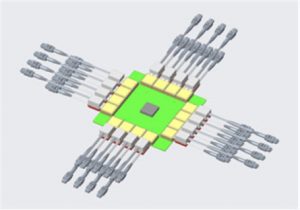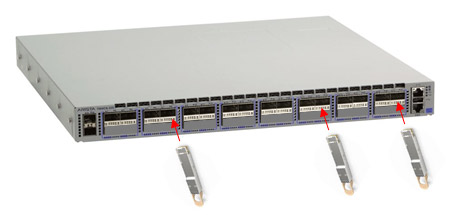External Light Source for Co-Packaged Optics
In comparing to pluggable optical transceivers, Co-Packaged Optics (CPO) is an optical transceiver technology aiming at increasing the port density and optical/electrical interface speed, while decreasing power consumption significantly. They are designed for future applications such as multi-terabits per second processor-based artificial intelligence (AI) and machine learning (ML), and ≥ 51.2 Tb/s Ethernet switches in data centers. As a result, industry-wide CPO transceiver studies and coordination have recently been started in CPO Collaboration Joint Development Forum [1], OIF [2], and COBO [3].
In the case of enabling ≥ 51.2Tb/s Ethernet switches in data centers, multiple (e.g., 16) CPO transceivers are surrounding the central Ethernet switch (see Fig.1), which consumes several hundred watts of power (today’s state-of-the-art 25.6Tb/s switch is already at 300+ Watts, see for example [4]). All CPO transceivers must be kept within a close proximity (e.g., < 5 cm bump to bump) to a hot central switch in order to maintain a high RF signal fidelity at 112 Gb/s per lane (which would evolve to 224 Gb/s in about four years) [5]. However, due to the proximity of the CPO transceivers to a hot central switch, silicon photonic ICs (PICs) are typically used to interface with the switch. This is because the silicon PICs are insensitive to a wide operating temperature variation [6]. On the other hand, a laser source based on Indium Phosphide material in general is a lot more sensitive to operational temperature, and its reliability would be degraded if it is also located too close to a central switch. This is the case for CPO modules with built-in DFB lasers [7] in which case a secondary laser has to be fabricated to back up the primary laser.

Fig. 1 16 CPO transceivers surrounding a central Ethernet switch [2]
An alternative method of providing CW light source (together with the associated micro-controller, thermoelectric cooler, DC-to-DC converters, etc.) to temperature-insensitive silicon PICs is to put the lasers external to the switch box, as shown in Fig.2, and therefore the name External Light Source (ELS). The pluggable modules (such as DD-QSFP) in Fig.2 can contain multiple semiconductor lasers with wavelengths normally in the O-band. The electrical power supplies to the multiple lasers in a pluggable module are obtained through the module connector pins and the socket on the switch box panel. The optical output for each laser can be either a pigtail or a blind-mated connector, and it is the latter that is used in the pluggable ELS module example shown in Fig.2. The concept of using a pluggable ELS module is interesting because not only the eye safety issue is resolved, but also it can be field-replaceable upon malfunctioning. Assuming all other CPO components and Ethernet switch are highly reliable, the entire Ethernet switch box can be reliable and good for practical use when pluggable ELS modules are used.

Fig.2 External light source in a pluggable module. Ethernet Switch Box has all CPO transceivers (except lasers) inside.
The industry trend is to let each laser’s output power be 18~23 dBm so that it can be shared by 4 to 8 silicon modulators in CPO transceivers. The 1:N (N=4 or 8) splitters for laser power sharing can be integrated on a silicon photonic PIC. The optical fibers connecting an ELS and a CPO transceiver is supposed to be polarization-maintaining fibers, which require a careful mechanical design at the junction of a blind-mated connector. Also, inside a switch box, a single N+1:N or multiple 1:2 optical protection switches might need to be included to enhance the overall system reliability. Generally speaking, the standard organizations still need to work out many detailed optical, electrical, thermal, and mechanical parameters with respect to ELS.
本文地址:http://www.iccsz.com//Site/EN/News/2021/05/31/20210531075406387784.htm 转载请保留文章出处
关键字: External Light Source CPO
文章标题:External Light Source for Co-Packaged Optics
※我们诚邀媒体同行合作! 联系方式:讯石光通讯咨询网新闻中心 电话:0755-82960080-188 debison
- 设置首页 | 光通讯招聘 | 企业搜索库 | 广告服务 | 联系我们 | 保护私隐 | 公司介绍
Copyright ? 2009 ICCSZ.com Inc. All Rights Reserved. 讯石公司 www.iccsz.com版权所有 粤ICP备06064786

